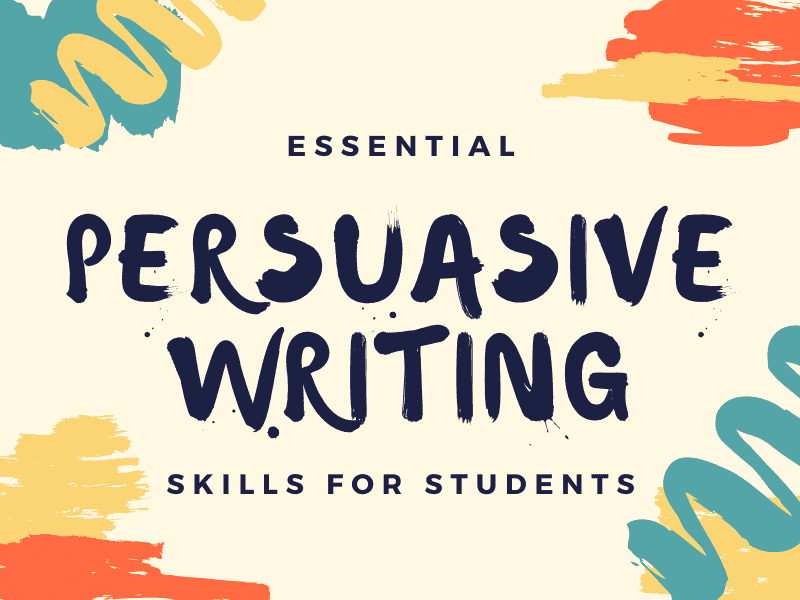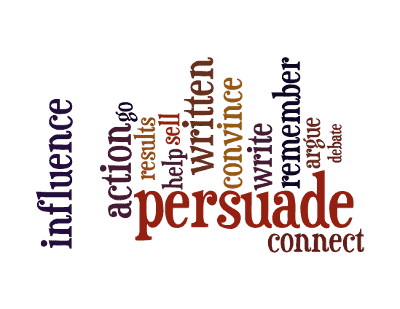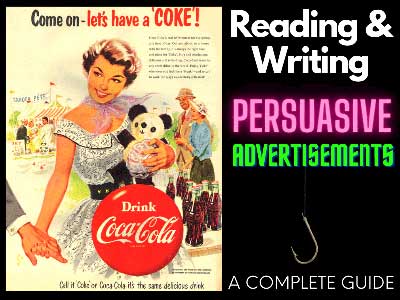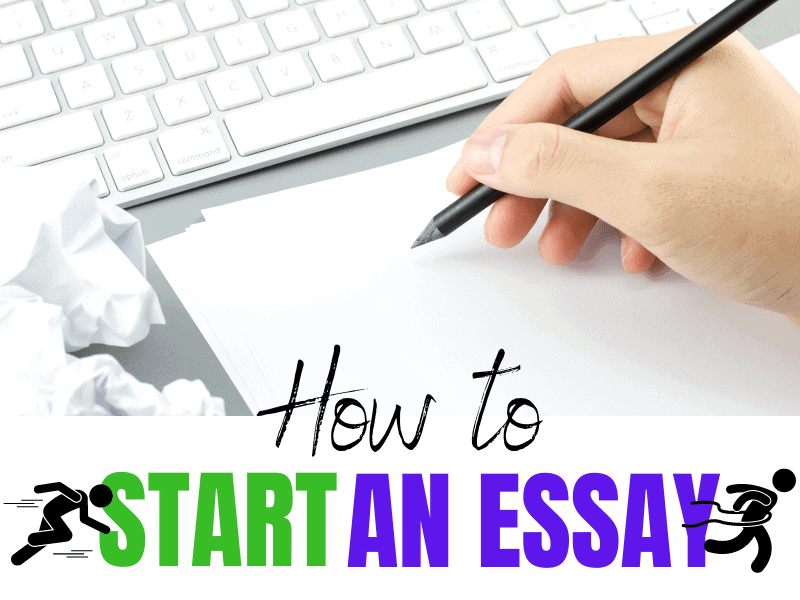Persuasive Writing a Letter for 5th Grade Oreo

WHAT IS A PERSUASIVE ESSAY?

A persuasive text presents a point of view around a topic or theme that is backed by evidence to support it.
The purpose of a persuasive text can be varied. Maybe you are intending to influence someone's opinion on a specific topic or you might be aiming to sell a product or service.
The challenge in writing a good persuasive text is to use a mix of emotive language and in some cases images that are supported by hard evidence or other people's opinions.
In a persuasive essay or argument essay, the student strives to convince the reader of the merits of their opinion or stance on a particular issue. To convince the reader of a point of view, or to take a specific action, the student must utilize a number of persuasive techniques to form a coherent and logical argument.

PERSUADING PEOPLE REQUIRES A CONSISTENT APPROACH…
Persuasive texts are simple in structure. You simply need to clearly state your opinion around a specific topic and then repeatedly reinforce your opinions with external facts or evidence. A strong concluding summary should leave little doubt in the reader's mind. ( Please view our planning tool below for a detailed explanation. )
A COMPLETE UNIT ON PERSUASIVE WRITING SKILLS

Teach your students to write excellent persuasive essays and influential writing skills using proven writing strategies and engaging content. ALL CONTENT, RESOURCES AND ASSESSMENT TOOLS INCLUDED.
A complete 140 PAGE unit of work on persuasive texts for teachers and students. No preparation is required.
THE STRUCTURE OF A PERSUASIVE ESSAY
1. Introduction
In the introduction, the student will, naturally, introduce the topic. Controversial issues make for great topics in this writing genre. It's something of a cliche in polite society to discourage discussions involving politics, sex, or religion for the reason that they can often be very divisive. While these subjects may not be the best topics of conversation for the dinner table at Thanksgiving, they can be perfect when deciding on a topic for persuasive writing. Obviously, the age and abilities of the students should be considered, as well as cultural taboos, when selecting a topic for the essay. But, the point holds, the more controversial, the better.
Let's take a look at some of the key elements of the introduction:
Title:
This will often be posed as a question, for example, if the essay is on the merits of a vegetarian lifestyle it may be called something like: To Eat Meat or Not?
Hook:

As with any genre of writing, capturing the reader's interest from the outset is crucial. There are a number of methods of doing this, known as hooks. Students may decide to open their essay with an anecdote, a joke, a quotation, or a relevant statistic related to the topic under discussion.
Background:
In this section of the introduction, students will provide the reader with some background to the topic. This will place the issue in context and briefly weigh up some of the different opinions on the subject.
Thesis statement:
After surveying the topic in the first part of the introduction, it is now time for the student writer to express their own opinion and briefly preview the points they will make later in the essay.
2. Body Paragraphs
The number of paragraphs that will form this section of the essay will depend on the number of points the writer chooses to make to support their opinion. Normally three main points will be sufficient for beginning writers to coordinate. For more advanced students, they can simply increase the number of paragraphs based on the complexity of their arguments, but the overall structure will largely remained intact.
Be sure to check out our own complete guide to writing perfect paragraphs here.
The TEEL acronym is a useful way for students to remember how to structure their paragraphs. Read below for deeper understanding.
Topic Sentence:
The topic sentence states the central point of the paragraph. This will be in the form of one of the reasons in support of the thesis statement made in the introduction.
Explain:
These sentences will build on the topic sentence by illustrating the point further, often by making it more specific.
Evidence:
It is the purpose of these sentences to support the paragraph's central point by providing supporting evidence and examples. This evidence may take the form of statistics, quotations, or anecdotal evidence.
Link:
The final part of the paragraph links back to the initial statement of the topic sentence, while also forming a bridge to the next point to be made. This part of the paragraph provides some personal analysis and interpretation of how the student arrived at their conclusions and also connects together the essay as a cohesive whole.
3. Conclusion
The conclusion weaves together the main points of the persuasive essay. It does not normally introduce any new arguments or evidence but rather reviews the arguments made already and restates them by summing them up in a unique way. It is important at this stage to tie everything back to the initial thesis statement. This is the writer's last opportunity to drive home their point; to achieve the goal of the essay, to begin with – persuade the reader of their point of view.
Ending an essay well can be challenging, but, especially for persuasive essays, it is essential to end strongly. As with the hooks of the essay's opening, there are a number of tried and tested methods of leaving the reader with a strong impression. Encourage students to experiment with different types of endings, for example, concluding the essay with a quotation that amplifies the thesis statement. Another method is to have the student rework their ending in simple monosyllabic words, as simple language often has the effect of being stronger in impact. The effect they are striving for in the final sentence is the closing of the circle.
There are a number of persuasive writing techniques that can be used to in the conclusion, and throughout the essay, to amp up the persuasive power of the writing. Let's take a look at a few.

4. Persuasive Techniques
In this article, we have outlined a basic structure that will be helpful to students in approaching the organization of their persuasive writing. It will also be helpful for the students to be introduced to a few literary techniques that will help your students to present their ideas in a convincing manner. Here are a few of the more common ones:
Repetition: There is a reason why advertisements and commercials are so repetitive – repetition works! Students can use this knowledge to their advantage in their persuasive writing. It is difficult to get the reader to fully agree with the writer's opinion if they don't fully understand it. Saying the same thing in a variety of ways ensures the reader gets many bites at the 'understanding' cherry.
Storytelling: Humans tend to understand things better through stories. Think of how we teach kids the important values through time-tested fables like Peter and the Wolf. Whether through personal anecdotes or reference to third person experiences, stories help climb down the ladder of abstraction and reach the reader on a human level.
Dealing with Dissent: We live in a cynical age, so leaving out the opposing opinion will smack of avoidance to the reader. Encourage your students to turn into that opposing viewpoint and deal with those arguments in their essay too.
A Call to Action: A staple of advertising, a call to action can also be used in persuasive writing. When employed, it usually forms part of the conclusion section of the essay and asks the reader to do something, such as, recycle, donate to charity, sign a petition etc.
A quick look around reveals to us the importance of the power of persuasion, whether, in product advertisements, newspaper editorials, or political electioneering, persuasion plays an important role in our daily lives. Logic and reason are important in the persuasion process, but they are not the only techniques. The dark arts of persuasion can prey on emotion, greed, and bias. Learning to write persuasively can help our students to recognize well-made arguments, as well as help to inoculate them against the more sinister manifestations of persuasion.
Now, go persuade your students of the importance of perfecting the art of persuasive writing!
A COMPLETE FACT & OPINION UNIT

ThisHUGE 120 PAGE resource combines four distinct fact and opinion activities you can undertake as aWHOLE GROUP or asINDEPENDENT READING GROUP TASKS in eitherDIGITAL orPRINTABLE TASKS.
- Fact & Opinion Mini-Lesson and overview
- Link to Google Slides Version for independent/interactive use
- 16 Fact and Opinion Discovery Task cards
- 16 Fact & Opinion Statements
- 5 x Convert Facts to Opinions Writing Tasks
- 10 x Unique Fact & Opinion Digital Print Graphic Organizer Tools
- Fact and Opinion Visual Writing Prompt Tasks
- Fact and Opinion Huge Collection of Printables
TIPS FOR WRITING A GREAT PERSUASIVE ESSAY
- Never leave any doubt about your position and point of view in the introduction.
- The stronger the evidence the stronger your argument will be. Take some time to find strong supporting evidence.
- Use paragraphs effectively. Each new element of your argument should start with a new paragraph.
- Play on the feelings of your audience. Use strong and emotive language but never become irrational.
- Persuasive texts are always written in present tense.

Teaching Resources
Use the resources and tools below with your students to improve their writing skills through proven teaching strategies.

20 POPULAR PERSUASIVE ESSAY TOPICS FOR STUDENTS
Writing an effective persuasive essay demonstrates a range of skills that will be of great use in nearly all aspects of life after school.

In essence, if you can influence a person to change their ideas or thoughts on a given topic through the manner in which you structure your words and thoughts you possess a very powerful skill.
Be careful not to rant wildly. Use facts and other peoples ideas who think similarly to you in your essay to strengthen your concepts.
Your biggest challenge in getting started may well be choosing a suitable persuasive essay topic. These 20 essay prompts should make this process a little easier.
- WHY ARE WE FASCINATED WITH CELEBRITIES AND WEALTHY PEOPLE ON TELEVISION AND SOCIAL MEDIA?
- IS IT RIGHT FOR SCHOOLS TO RAISE MONEY BY SELLING CANDY AND UNHEALTHY FOODS TO STUDENTS?
- SHOULD GIRLS BE ALLOWED TO PLAY ON BOYS SPORTING TEAMS?
- IS TEACHING HANDWRITING A WASTE OF TIME IN THIS DAY AND AGE?
- SHOULD THERE BE FAR GREATER RESTRICTIONS AROUND WHAT CAN BE POSTED ON THE INTERNET?
- SHOULD PROFESSIONAL ATHLETES HAVE TO TAKE DRUG TESTS?
- ARE TEENAGE PREGNANCY SHOWS A NEGATIVE OR POSITIVE INFLUENCE UPON VIEWERS?
- SHOULD GAMBLING BE PROMOTED IN ANY WAY IN SPORTS EVEN THOUGH IT BRINGS IN LARGE AMOUNTS OF REVENUE?
- SHOULD SPORTING TEAMS THAT LOSE BE REWARDED BY RECEIVING INCENTIVES SUCH AS HIGH DRAFT PICKS AND / OR FINANCIAL BENEFITS?
- SHOULD SHARKS THAT ATTACK PEOPLE BE DESTROYED?SHOULD WE GET INVOLVED IN FOREIGN CONFLICTS AND ISSUES THAT DON'T DIRECTLY AFFECT OUR COUNTRY?
- SHOULD WE GET INVOLVED IN FOREIGN CONFLICTS AND ISSUES THAT DON'T DIRECTLY AFFECT OUR COUNTRY?
- COULD VIDEO GAMES BE CONSIDERED AS A PROFESSIONAL SPORT?
- IF YOU WERE THE LEADER OF YOUR COUNTRY AND HAD A LARGE SURPLUS TO SPEND WHAT WOULD YOU DO WITH IT?
- WHEN SHOULD A PERSON BE CONSIDERED AND TREATED AS AN ADULT?
- SHOULD SMOKING BECOME AN ILLEGAL ACTIVITY?
- SHOULD THE VOTING AGE BE LOWERED?
- DOES PROTECTIVE PADDING IN SPORT MAKE IT MORE DANGEROUS?
- SHOULD CELL PHONES BE ALLOWED IN THE CLASSROOM?
- IS TEACHING A FOREIGN LANGUAGE A WASTE OF TIME?
- SHOULD WE TEACH ETIQUETTE IN SCHOOLS?
PERSUASIVE PROMPTS FOR RELUCTANT WRITERS
If your students need a little more direction and guidance here are some journal prompts that include aspects to take into consideration.
- Convince us that students would be better off having a three day weekend. There are many angles you could take with this such as letting children maximize their childhood or and trying to convince your audience that a four day school week might actually be more productive.
- Which is the best season? And why? You will really need to draw on the benefits of your preferred season and sell them to your audience. Where possible highlight the negatives of the competing seasons. Use lots of figurative language and sensory and emotional connections for this topic.
- Aliens do / or don't exist? We can see millions of stars surrounding us just by gazing into the night sky suggesting alien life should exist right? Many would argue that if there were aliens we would have seen real evidence of them by now. The only fact is that we just don't know the answer to this question. It is your task to try and convince your audience through some research and logic what you point of view is and why.
- School uniforms should be mandatory? Do your own research on this popular and divisive topic and make your position clear on where you stand and why. Use plenty of real world examples to support your thoughts and points of view.
- Should Smartphones be banned in schools? Whilst this would be a complete nightmare for most students' social lives, maybe it might make schools more productive places for students to focus and learn? Pick a position and have at least three solid arguments to support your point of view and sell them to your audience.
Persuasive Essay Examples (Student Writing Samples)
Below are a collection of student writing samples of persuasive essays. Click on the image to enlarge and explore them in greater detail. Please take a moment to both read the persuasive texts in detail but also the teacher and student guides which highlight some of the key elements of writing a persuasion.
Please understand these student writing samples are not intended to be perfect examples for each age or grade level but a piece of writing for students and teachers to explore together to critically analyze to improve student writing skills and deepen their understanding of persuasive text writing.
We would recommend reading the example either a year above and below, as well as the grade you are currently working with to gain a broader appreciation of this text type.
- Year 4
- Year 6
- Year 6
- Year 8
VISUAL JOURNAL PROMPTS FOR PERSUASIVE WRITING
Try these engaging persuasive prompts with your students to ignite the writing process. Scroll through them.
WHERE CAN I FIND A COMPLETE UNIT OF WORK ON HOW TO WRITE PERSUASIVE ESSAYS?


We pride ourselves on being the web's best resource for teaching students and teachers how to write a persuasive text. We value the fact you have taken the time to read our comprehensive guides to understand the fundamentals of writing skills.
We also understand some of you just don't have the luxury of time, or the resources to create really engaging resources exactly when you need them.
If you are time-poor and looking for an in-depth solution that encompasses all of the concepts outlined in this article I strongly recommend taking a look at the "Writing to Persuade and Influence Unit."
Working in partnership alongside Innovative Teaching Ideas we confidently recommend this resource as an all in one solution to teach how to write persuasively.
Within this unit, you will find over 140 pages of engaging and innovative teaching ideas.
PERSUASIVE ESSAY WRITING CHECKLIST AND RUBRIC BUNDLE

VIDEO TUTORIALS FOR PERSUASIVE WRITING
OTHER GREAT ARTICLES RELATED TO PERSUASIVE ESSAY WRITING

The Complete Guide to Opinion Writing for Students and Teachers
The Importance of Opinion Writing Encouraging our students to express their personal opinions is an important part of the learning process; healthy even. To do this effectively, it is equally important that we help them acquire the necessary skills to express these opinions in a reasoned and coherent manner. Writing is one of the best…

Top 5 Persuasive Writing Techniques for Students
Explore the essential skills students and teachers should possess to become great persuasive writers.

5 Top Persuasive Writing Lesson Plans for Students and Teachers
Learn how to teach the fundamentals of persuasive writing in just five days with these lesson plans, tools, resources and teaching strategies to improve your student's persuasive essay. We provide the solutions to answering what a persuasive text is? How to use persuasive language and techniques and advice for teachers and students about persuasive and opinion writing.


How to write an advertisement: A Complete Guide for Students and Teachers
As with persuasive texts in general, advertisements can take many forms – from billboards and radio jingles to movie trailers and pop-ups on your computer. In this guide, we'll work towards writing a standard magazine format advertisement known as the print ad. Print ads are text-heavy enough to provide something meaty for our students to…

How to Start an Essay with Strong Hooks and Leads
"A good start is half the work" Old Irish Proverb HOW TO START AN ESSAY: A COMPLETE GUIDE Getting started is often the hardest part of writing an essay and it's one of the main reasons our students are prone to leaving their writing tasks to the last possible minute. But, what if we were…
Content for this page has been written by Shane Mac Donnchaidh. A former principal of an international school and university English lecturer with 15 years of teaching and administration experience. Shane's latest Book the Complete Guide to Nonfiction Writing can be found here. Editing and support for this article have been provided by the literacyideas team.
Persuasive Writing a Letter for 5th Grade Oreo
Source: https://literacyideas.com/persuasive-essays/
0 Response to "Persuasive Writing a Letter for 5th Grade Oreo"
Postar um comentário